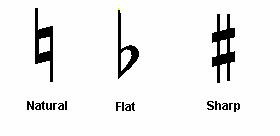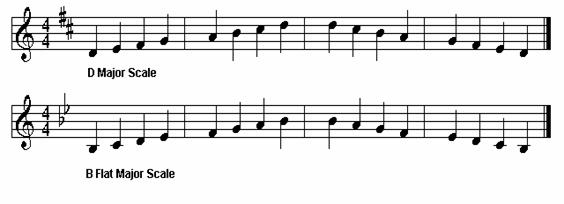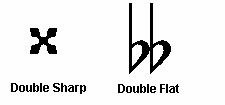Section 6: Accidentals
Accidental: Any of various signs that indicate the alteration of a note by one or two semitones or the cancellation of a previous sign.
In some cases you will find what is called an accidental. It is a Sharp, Flat, or Natural sign used to change the pitch of a note on the staff so that it is played outside of the defined key. Before we go any further into that, let us define Sharp, Flat, and Natural and how they relate to music.

Figure 2d (Accidentals)
The relationship between accidentals is a half step up or down from the note that it accompanies. Sharps and Flats are in between the natural note. Let us look at two scales ascending and descending, (the D Major and B Flat Major Scales), so you can see the different Key Signatures put to use and the use of accidentals.

Figure 2e (D Major & B Flat Major Scales)
As you can see, Key Signatures are actually accidentals that apply to the entire song. Every "C" and "F" note will be played as sharp or a half step higher than natural note in the D Major scale. Every "B" and "E" note played will be flat or half step lower than the natural note in the B Flat Major scale. It is very common to see the natural symbol next to a note, when the key signature defines a flat or a sharp to the song that is being played.

Figure 2f (Natural Accidentals)
In Figure 2f, notice that the second staff of the sample music uses a natural accidental to change the C#, (C sharp), as defined by the key signature, to a C natural. The next measure changes it back to a C#.
It is very important to note that any note can be made sharp, flat, or natural at any time in music. Usually when reviewing a composition, composers will often site read and play what they have written and will often times mark a note with an accidental.
It is also important to note that an accidental in music will more often than not, apply to the measure in which it was used. In the bottom staff of Figure 2f, the sharp accidental was defined. If it was not defined, the key signature would apply and the note would be played as a sharp. Remember that it is always good practice to notate accidentals like this when composing music.
Looking at the relationship of accidentals it is best to break it down like this:
- A Flat is the Sharp of the note below it. (e.g. E Sharp and F Flat is the same note)
- A Sharp is the Flat of the note above it. (e.g. A Sharp and B Flat is the same note)
- The exceptions to the rule are the B and E pitches. There is no "B Sharp" or "E Sharp".
- Coming down the progression there is no "C Flat" or "F Flat".
The pitch of "B Sharp" is a C Natural. Likewise, the pitch of "E Sharp" is an F Natural. Coming down the progression, a "C Flat" is a B Natural, and an "F Flat" is an E Natural. With regards to all of the above you should never see a B Sharp, E Sharp, C Flat, or F Flat written on a score except in theory or spelling to break up progressions of having multiple pitches on the same staff line.
An example would be a musical piece with chromatic progressions, where you would have sharps, flats, and naturals on the same staff line. Instead you will see the natural notes applied, (C, F, B, and E).
Take a look at Illustration B.
Counting the whole step and half step note relations, here are the progressions.
| Accidental Progressions |
| E |
| F |
| F# / Gb |
| G |
| G# / Ab |
| A |
| A# / Bb |
| B |
| C |
| C# / Db |
| D |
| D# / Eb |
| E |
Illustration B (Whole and Half Step Accidental Relationships)
From the note E to the note F, is one whole step. From the F natural note to F Sharp/B Flat is a half step.
If you were to play a C# then play a D Flat, it would be the same tone. So how do you know when to use a Flat or a Sharp? One of the techniques used in this course defines use like this. When you are ascending in pitch you use sharps. When you are descending in pitch, use flats. The way we write these notes is called the spelling of the notes.
The spelling of sharps and flats by relation differ. D# and Eb is the same note. These differences in spelling are called enharmonic, referring to the same pitch being spelled differently according to the key it is written in.
But for right now, understand that when you think of "Sharp" it is higher in pitch, so when you play a piece of music that rises in pitch, we will use a sharp to signal a half step rise in the pitch. Likewise, when you think of "Flat" it is lower in pitch, so when you play a piece of music that goes down in pitch, we will use a flat to signal a half step drop in the pitch. It is easier to remember the phrase, "Sharpen up or get flattened down."
Perception between a musician and a composer may differ slightly when it applies to performance. On many occasions, when there is a key signature at the beginning of the piece, the natural progression is viewed as a natural whole step.
For example, in the key of D Major there are two accidentals that make up the key signature. They are C Sharp and F Sharp. While the composer would view a note progression from B to C Sharp as one and one half step, (a whole step from B to C, and a half step from C to C Sharp), the performer will often times view it as a whole step, because the key signature defines every C pitch as a sharp, and any other accidental would be a half step deviation from the normal outlined by the key signature.
This is a matter of perception and is applied as a matter of methodology to simplify performing, but does not change the real progression as it applies to a whole or a half step.
There are two more accidentals that we will mention here, but will not go into until later in the course. They form a specific group of accidentals called "Double Accidentals," (See Figure 2g).

Figure 2g (Double Accidentals)